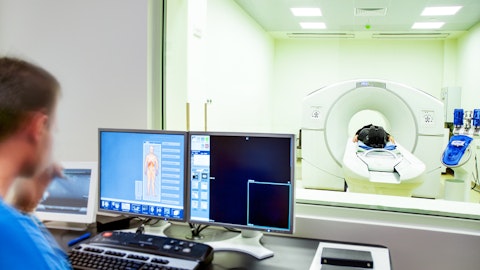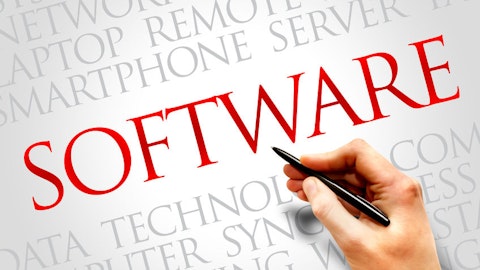Matthew VanVliet: Hey, good afternoon, and thanks for taking the questions. I guess as you look at, specifically on the PMS side of the pipeline here, I guess, how much of the build and sort of record levels that you’re seeing there would you attribute to just sort of the product now being more modern and more easily deployed and integrated with other systems? And would you lend any I guess support to the more halo effect of having won the Marriott deal and sort of getting into opportunities that might not otherwise have materialized?
Ramesh Srinivasan: Yes. Hi, Matthew. Yes, the Marriott deal has definitely given us credibility in the PMS area, no question, right? Because now, there was a time before when we were not included in many PMS RFPs and I can’t blame customers for that. But now, with the Marriott deal, we have credibility, now it is tough to exclude us, and which is all we wanted. Now in the meanwhile, there are also two other factors, Matt. One of them is the fact the product is in a much, much better state now and you cannot ignore it, and once you see it, you get very interested in it. So, that’s one factor. And a couple of other factors I would mention is, number one, the market is hungry for innovation. So, at least in our opinion, the providers who had dominated the space, the innovation speed has not been that great during the past few years.
So, someone had to fill that innovation gap and customers find these products to be far ahead of the competition once they take a look at it. And the biggest factor also is, we built an ecosystem of PMS products. It’s not only the core PMS. It’s also all, it’s about 15 to 20 add-on Experience Enhancer modules around it, and many customers are preferring to reduce the number of vendors they deal with. It is not just a matter of making integrations easier, it is also a matter of pace of innovation. Like you come up with a good idea in golf or spa, and you want a corresponding change in the PMS, it’s much easier for us to do all those changes in the next release and customers love the fact. So, I would say that the momentum that is building for us in PMS is attributable to all those reasons.
One, the Marriott deal gave us credibility; two, the product is competitively at a much better state and we can answer yes to both being in the cloud and on-premise; third, this industry has always been hungry, it’s become hungry for those kinds of good products; and fourth, of course, the ecosystem of PMS products we have built. All that is contributing to our momentum now, Matt.
Matthew VanVliet: Okay. Very helpful. And then, Dave, you mentioned that less than 10% of services revenue is coming from, I presume Marriott. But the contracts, that subscription will be in later years. Is that sort of the appropriate level we should think about in terms of the mix over the next several quarters as you get closer to the rollout there or should that uptick? And I guess with that, how would you correlate that with utilization rates across the services organization more broadly?
Dave Wood: Yes. So, I mean it just stayed less than 10%. I mean as you would imagine, it will go up and down on a quarterly basis, but the far majority of our 90%-plus is non-large deal services working toward our subscription revenue. But yes, it will go up and down, but we’re not expecting it to get larger than 10% in the next couple of quarters. And utilization of the services team has been really well. I mean, the best thing to point to there is the margin, right. I mean we’ve seen over the last couple of quarters, roughly a 10% margin increase in the professional services team and a lot of that is just more billable — obviously, more billable work and less non-billable work as we work through some of our prior implementation efficiencies and just work through the backlog.
Ramesh Srinivasan: And the crucial thing to keep in mind, Matt, is this would have been a record services quarter for us regardless, even without the influence of that product development-related revenue, it would have been a record quarter for us. And year-over-year, it’s improved by 41%, so only a part of that can be attributed to this product development work that we are doing. The main indicator here, Matt, the crucial thing is, it’s an indicator that our new products are settling down well in the field and are becoming easier and faster to implement, which is the biggest thing we take out of our services revenue quarter.
Matthew VanVliet: Great. And then one last one quickly, if I could squeeze it in. As you look at the longer term, I guess, upside to margins that’s potentially in the model here, anything limiting further upside as growth continues on the top-line? Any major investments that you foresee having to make that could impede that or should we expect, with appropriate top-line growth, a fair amount of leverage going forward? Thanks.
Ramesh Srinivasan: Yes, Matt. With continuing top-line growth, you should expect improving leverage across practically all our operating expenses categories. You should expect improving operating leverage as we go along. But remember, from a quarter to quarter, I would not apply those rules. But on a year-over-year basis, this fiscal year, the next fiscal year, and so on, you should expect profitability levels to continue improving as our revenue levels improve. And especially on the R&D side of it, we have a fair amount of leverage. I mean, it is not as if R&D is going to go down, but it’s going to be tempered. The R&D increases are going to be tempered compared to the revenue growth. And also, our gross margin is improving now. As recurring revenue becomes a higher proportion of our total revenue and our services revenue becomes a higher proportion as well, you should expect, overall, our profitability to continue improving as our top-line revenue increases.
Matthew VanVliet: Great. Thank you.
Operator: And, thank you. [Operator Instructions] And one moment for our next question. And our next question comes from George Sutton from Craig-Hallum Capital. Your line is now open.
George Sutton: Thank you. Ramesh, you mentioned that you grew subscription revenues 29.9%. I would like to give you a sell-side roundup and say congratulations for your 30% growth. I wanted to make sure, given that both Marriott and Hilton put out pretty positive indications about room growth today. So, obviously, the industry is growing very healthy. But with Marriott specifically is, they’re announcing these big room increase numbers, can you just walk through how we think of that relative to what that means for your ultimate contract?




